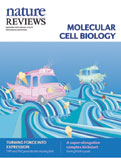|
Advertisement | ||||||||||||||||||||||||||||||||||||||||||||||
| ||||||||||||||||||||||||||||||||||||||||||||||
| TABLE OF CONTENTS | ||||||||||||||||||||||||||||||||||||||||||||||
| September 2012 Volume 13 Number 9 | Advertisement | |||||||||||||||||||||||||||||||||||||||||||||
| In this issue
|
| ||||||||||||||||||||||||||||||||||||||||||||
| ||||||||||||||||||||||||||||||||||||||||||||||
 | ||||||||||||||||||||||||||||||||||||||||||||||
| Advertisement | ||||||||||||||||||||||||||||||||||||||||||||||
| ||||||||||||||||||||||||||||||||||||||||||||||
| ||||||||||||||||||||||||||||||||||||||||||||||
| PROGRESS | Top | |||||||||||||||||||||||||||||||||||||||||||||
| The super elongation complex (SEC) family in transcriptional control Zhuojuan Luo, Chengqi Lin & Ali Shilatifard p543 | doi:10.1038/nrm3417 The super elongation complex (SEC) consists of the RNA polymerase II (Pol II) elongation factors eleven-nineteen Lys-rich leukaemia (ELL) proteins, positive transcription elongation factor b (P-TEFb) and several frequent mixed lineage leukaemia (MLL) translocation partners. The SEC controls transcription elongation in the presence or absence of promoter-proximal paused Pol II, and its gene target specificity depends on protein components forming distinct SEC complexes. Abstract | Full Text | PDF | ||||||||||||||||||||||||||||||||||||||||||||||
| REVIEWS | Top | |||||||||||||||||||||||||||||||||||||||||||||
| STIM proteins: dynamic calcium signal transducers Jonathan Soboloff, Brad S. Rothberg, Muniswamy Madesh & Donald L. Gill p549 | doi:10.1038/nrm3414 STIM proteins sense subtle changes in the levels of endoplasmice reticulum (ER)-stored Ca2+ and respond by regulating extracellular Ca2+ entry and cell signalling. New structural and functional data have shed light on the role of STIM proteins as stress sensors. Abstract | Full Text | PDF | Supplementary information | ||||||||||||||||||||||||||||||||||||||||||||||
| Mitochondria as sensors and regulators of calcium signalling Rosario Rizzuto, Diego De Stefani, Anna Raffaello & Cristina Mammucari p566 | doi:10.1038/nrm3412 Ca2+ uptake through specialized transporters allows mitochondria to act as buffers of intracellular Ca2+ levels. Moreover, mitochondrial Ca2+ signalling regulates vital processes, including metabolism and cell death. Therefore, mitochondrial Ca2+ signalling remains at the epicentre of cell biological research. Abstract | Full Text | PDF | Supplementary information | ||||||||||||||||||||||||||||||||||||||||||||||
| DNA damage checkpoints in stem cells, ageing and cancer Tobias Sperka, Jianwei Wang & K. Lenhard Rudolph p579 | doi:10.1038/nrm3420 Like all cell types, stem cells are subject to DNA damage, which results in the activation of checkpoint proteins, for example p53. These checkpoint responses lead to the clearance of damaged cells by cell-intrinsic and cell-extrinsic mechanisms, preventing carcinogenesis, but may also impair stem cell and tissue maintenance, thereby promoting ageing. Abstract | Full Text | PDF | ||||||||||||||||||||||||||||||||||||||||||||||
| PERSPECTIVES | Top | |||||||||||||||||||||||||||||||||||||||||||||
| OPINION Transduction of mechanical and cytoskeletal cues by YAP and TAZ Georg Halder, Sirio Dupont & Stefano Piccolo p591 | doi:10.1038/nrm3416 Forces transmitted through cell-cell and cell-extracellular matrix adhesions control cell fate decisions. But how are mechanical cues translated into gene expression programmes? The transcriptional regulators YAP and TAZ have arisen as convergence points of mechanical and biochemical signals. Abstract | Full Text | PDF | ||||||||||||||||||||||||||||||||||||||||||||||
| Advertisement | ||||||||||||||||||||||||||||||||||||||||||||||
| ||||||||||||||||||||||||||||||||||||||||||||||
| ||||||||||||||||||||||||||||||||||||||||||||||
| *Journal Citation Reports, Thomson, 2011 |
You have been sent this Table of Contents Alert because you have opted in to receive it. You can change or discontinue your e-mail alerts at any time, by modifying your preferences on your nature.com account at: www.nature.com/myaccount For further technical assistance, please contact our registration department For print subscription enquiries, please contact our subscription department For other enquiries, please contact our feedback department Nature Publishing Group | 75 Varick Street, 9th Floor | New York | NY 10013-1917 | USA Nature Publishing Group's worldwide offices: Macmillan Publishers Limited is a company incorporated in England and Wales under company number 785998 and whose registered office is located at Brunel Road, Houndmills, Basingstoke, Hampshire RG21 6XS. © 2012 Nature Publishing Group, a division of Macmillan Publishers Limited. All Rights Reserved. |
 |











No comments:
Post a Comment